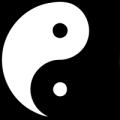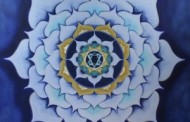 Yin-yang is the best known concept of Tao.
Yin-yang is the best known concept of Tao.
The yin-yang symbol; known also as the tai chi symbol, is shown below. It is the icon for Tao and Taoism.
What is Tao ?
Tao is the core concept of Taoism. Of Chinese origin, it is witten as 道, and literally means ‘the path’ or ‘the way’. Its actual meaning, however, is elusive and difficult to express in words. It may be defined as the ultimate principle of the universe embodied in all reality. There are many ways to apply Tao in life. Basically, it teaches us to flow with life and be ourselves.
What are yin and yang?
Yin and yang are two sides of dualism, just like the tail and the head of a coin. If the tail is yin, then the head is yang. They exist alongside one another. The head cannot exist without the tail, and the tail cannot exist without the head.
Everything in this world is a dualism. In it you can always find yin and yang.
Earth is yin, sun is yang. Woman is yin, man is yang. Sadness is yin, joyfulness is yang. Generally, yin is passive, oppressed and feminine; while yang is active, bright and masculine
Knowing yin and yang helps you to understand and manage reality.
You may be able to transform a situation by altering the yin-yang relationship or striking a new balance.
Try it next round when you are in a heated argument.
Instead of rebuttal, try keeping silent. Yin and yang exist as energy fields. In this case, heated argument is yang, and silence is yin. When you introduce silence during the debate, you are introducing the yin energy, and the energy field is altered as a result. The yang energy is now lower. If probably managed, you could achieve an amicable yin and yang balance, which is beneficial to the two parties.
Just imagine that you are doing the contrary. If instead of introducing silence, you argue. In this case, you bring more yang energy into the energy field. The yang energy would rise. If not probably managed, it could go out of hand, resulting in yin-yang off-balance, turning the relationship acrimonious.
This is like what Lao Tzu depicts in the following verse:
“Tao engenders One;
One engenders Two;
Two engenders Three;
Three engenders all things.
All things carry the yin (femininity)
while embrace the yang (masculinity).
Neutralising energy brings them into harmony.”
In this case, the silence could be one, and the heated argument two. When they interact in the way that you manage, it emerges the new yin-yang situation, which is known as three.
The yin and yang symbol is known also as tai chi symbol. It signifies infinite potentiality, and is the icon of Tao and Taoism. The symbol symbolizes an existence; which can be anything in the universe, from sun, moon and water to fire. It is in the shape of a circle, and consists of two colors – black and white. The black represents yin, and the white yang, which are opposing qualities of dualism. In the circle, there are two fish-like features. One of them is in black; and the other white. These fish-like features represent yin and yang energies respectively. The black fish is yin, and the white fish yang.
There is a black dot that looks like an eye in the white fish; and similarly a white dot in the black. Walking through the diameter of the circle, you will not experience pure black or pure white. There is always some black and some white. Yin and yang are rooted in one another. You find yin in yang, and yang in yin. This somehow reflects the reality of life, where there is rarely pure yin or pure yang. In happiness, there are seeds of sadness; and in every risk, there lies an opportunity. They wax and wane; and can be mutually transformed.
The yin-yang symbol is rounded, so as to gives a sense of continual movement and interaction of the two energies. Although yin and yang are opposites, they are complementary. At the same time, they are interchangeable. Yin turns into yang and yang turns into to yin, causing new yin-yang situation to establish. Our challenge in life is to balance the yin and yang in things we do. The better we are in finding the equilibrium, the more effective we can be, and to be the sage as Lao Tzu describes:
“The Sage who is
Forthright but not hurting;
Sharp but not wounding,
Candid but not being crude;
Shining but not dazzling.”
Vũ Kiếm Minh










































